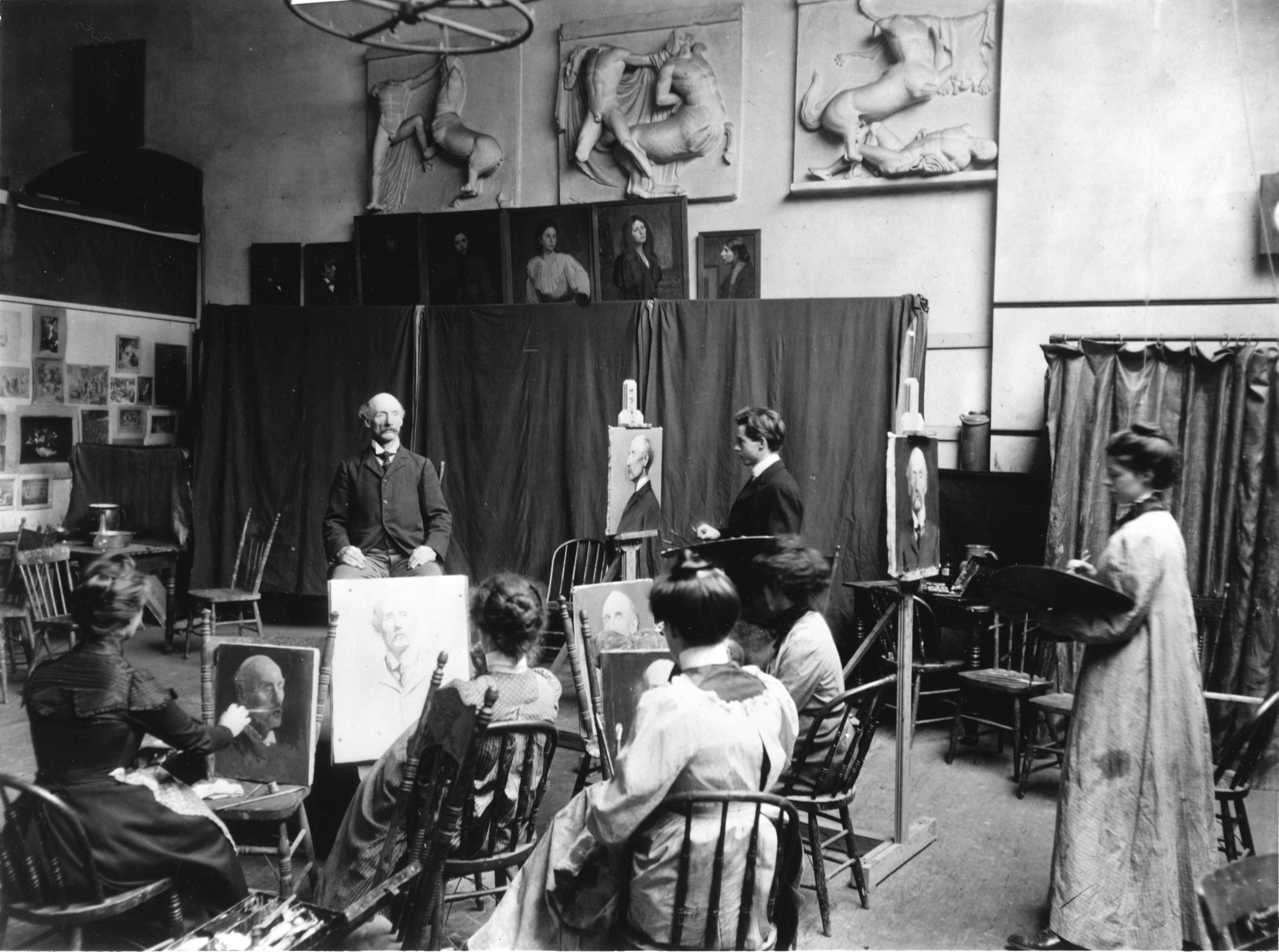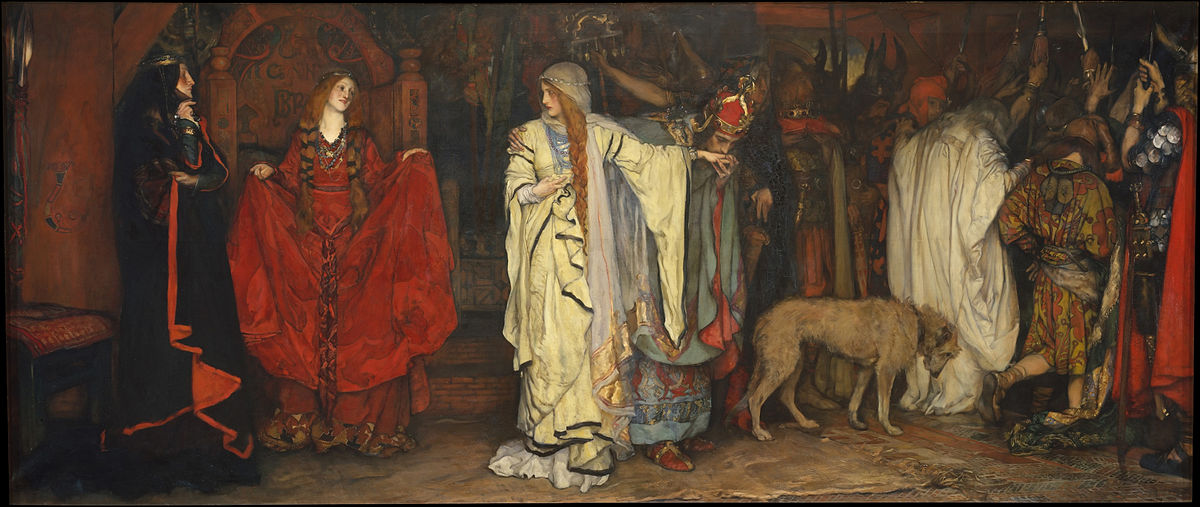In the following essay, a famous artist discusses the shortcomings of art education in America, and proposes some remedies. At the end of the post, I'll let you know who wrote the essay.
 |
| Pennsylvania Academy of the Fine Arts Portrait Class, 1901 |
"It seems to me that no one could seriously dispute the fact that a great school of art in America is needed, or that such a school would have the very greatest influence in the development both of the spirit and the practice of art. As art is now taught in this country, it is too fragmentary. The pupils are not thoroughly grounded. Any one who wants to study art here can do so. The examinations are too easy. In the foreign schools the examinations are very difficult. The student must know a good deal to pass them. There should be an American school with equally high requirements.
If a young man [or young woman] wants to enter Harvard or Yale, his preparation must be thorough. That is the way it should be with the school of art, for the school of art should really be like a university. The student, before being admitted to the university, should have passed beyond the elemental stage of study which properly belongs to the grammar-school grade. As it is now in America there is no place where parents who think their son is a genius can send that son to find out that he isn’t a genius. There are very few people who can’t be taught to draw more or less well, but the mere ability to draw does not make an artist.
"There seems to be a desire on the part of a very large number of persons either to become professional artists, sculptors, and painters or to acquire some of the principles of decoration. But there is also widespread ignorance that a thorough grounding in certain facts is absolutely essential to the serious student before he is prepared to avail himself of the experience of others.
Those who wish to study art here are admitted to classes far too leniently. In the schools abroad the entrance examinations are very severe, and by a succession of examinations, the less talented are eliminated. This refers, of course, to the great schools — not to the irresponsible studios, where a model or two is hired and a few painters with a present reputation are engaged to call in occasionally to give advice; to such schools anybody, with no experience whatever, can, by paying a small fee, be admitted.
It has been immensely to the advantage of America that there is nothing for architects abroad which corresponds with the irresponsible painting ateliers referred to. The student of architecture going to Paris, for instance — although my remarks do not apply to Paris alone — can only study his profession by going into the “Beaux Arts.” The entrance examination is very severe, of course, and should be so, but the effect upon the American student is everywhere apparent here, and has given the architects of the United States the great position they occupy to-day.
If the money is provided — and one of the things which surprises
me on coming back to America is the amount of money there seems
to be — there would seem to be no reason why a great American
school of art should not be established and be put in working order
within a reasonably short time. A building should be furnished,
among other things, with copies of the best examples of art in foreign
countries in sculpture, painting, and architecture. There would be
little difficulty in acquiring these, although it would take time.
The American Art Federation would be the institution which
would most naturally father the work of establishing an American
school. And the question of a location for the school would have to
be answered by circumstances. It should be in a center, some place
where it would be to the advantage of both pupils and instructors to
live. The location might be a problem. One would name New York
as the obvious place for the school, as the National Academy is
there, and the various art societies to which most American artists
contribute hold their exhibitions there.
The art ability of Americans is not to be belittled. The best
American artists can hold their own anywhere. American art as a
whole, however, has the tendency to be preoccupied with problems of
a technical nature, such as how to put on paint, and things of that sort.
The painting of individual pictures is not art in its highest form.
Pictures are only fragments. The great things are works which carry
an idea through to completion.
I do not think that the great problems of adapting one subject or
composition to its environment is sufficiently studied, if it is studied
at all. The three great branches of art — painting, sculpture, and
architecture — should be independent. Without a knowledge of the
other two, each is incomplete. The restraining influence the study
of each one has upon the others is of the greatest importance and of
the greatest service.
A school should have, first of all, the great artists of the country
as overseers. That is the method pursued in Munich, where the great
artists are given studios in the school, and the students are allowed,
several days in the week, to consult them about ideas. In addition
to the influence of American artists of first rank, the American school
might also make arrangements to receive the benefit and advice of
prominent foreign artists who are visiting this country from time to
time. As to the instructors, there should be many of them, and
there is no reason why they should not be drawn from the ranks of
American artists.
The curriculum of the school should embrace sculpture, painting,
and architecture, and every student should be made to learn something about all three branches of art. There are many Americans who are quite competent to act as instructors, under the supervision
of artists of first rank. And the great thing is that the school should
have one inspiring head. The advantage of having great artists on
the staff, to whom students can have access, lies in the fact that one
can learn much more by working with a man than by simply being
told what to do, or what not to do. The establishment of the school
would mean, primarily, the sifting out of the incapable. It would
push forward those who had real talent, and would discourage those
without talent.
An art atmosphere is hardly to be spoken of as something which is
created; it is rather something which happens. It is a matter of
tradition. A whole country grows up to art, and the atmosphere
comes gradually into being, one can hardly explain when or how.
And a people who have once developed an art atmosphere may
degenerate. Take Italy, for example. The Italy of the past was a
paradise of art. Rome is an eternal city because of the handiwork
which immortal artists have left there, if for no other reason. But
take the Italy of to-day—where is its art atmosphere? The average
modern Italian likes the worst pictures and loves noise. It would
seem as if all the art air had been breathed over there.
An art atmosphere is not generated entirely by pictures. The
kind of houses men build, and what they put into them; the decorations of public buildings; the beautifying of public parks; the care of
the streets, all these things play important parts. In this day, it is
not so much the love of pictures as care for vital things which needs
to be encouraged.
The generating of an art atmosphere requires a great deal of
money, as well as a great deal of good taste on the part of a great
many people. Public building decorations of the highest order are
so expensive as frequently to make them impossible. The artist who
does the work, too, must inevitably make sacrifices. But the man
who takes up the profession of art must have higher aims than financial considerations. The painting of an important and thoroughly
careful work is much more expensive than most people realize.
The essay was written by the American illustrator and painter Edwin Austin Abbey, and it appeared in Brush and Pencil
magazine. Abbey was an illustrator and painter, trained at the Pennsylvania Academy of Fine Arts. He was a good friend of John Singer Sargent, and alongside Sargent, he painted murals for the Boston Public Library. He lived and worked for most of his career in Great Britain, and exhibited regularly at the Royal Academy. The essay was published in the March, 1902 edition of Brush and Pencil
magazine.
Questions for discussion:
1. Abbey argues for maintaining high standards and weeding out those of lesser abilities. Is that position tenable in our time, and in today's art world?
2. Should an art school have a shared set of standards or values, and what should those standards be?
3. Why does our contemporary artistic culture allow for these standards in music conservatories, such as Julliard, Bard, or Eastman, but not in art schools?
4. He says "American art as a whole has the tendency to be preoccupied with problems of a technical nature, such as how to put on paint, and things of that sort." Is it still true that Americans are preoccupied with tools and technique?
5. Abbey argues that the curriculum should embrace painting, sculpture, and architecture. For those of you who have studied sculpture or architecture, what has that study given you as a painter?

















































